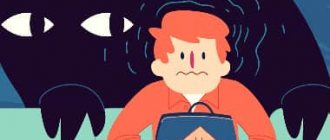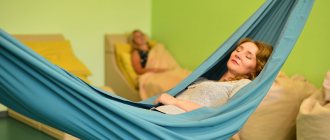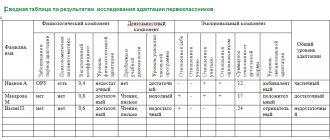This anxiety scale was developed by A.M. Prikhozhan in 1980-1983. according to the principle of O. Kondash’s “Scale of Social-Situational Fear and Anxiety”. The peculiarity of scales of this type is that in them anxiety is determined by a person’s assessment of the anxietyogenicity of certain situations in everyday life. The advantages of scales of this type are that, firstly, they make it possible to identify areas of reality that cause anxiety, and, secondly, they depend to a lesser extent on the ability of schoolchildren to recognize their experiences and feelings, i.e. on the development of introspection and the presence of a certain vocabulary of experiences.
This technique is intended for diagnosing the following types of personal anxiety in adolescents:
- anxiety associated with school situations (school anxiety),
- with communication situations (interpersonal),
- with attitude towards oneself (self-esteem).
- scale of mystical, magical fears (magical).
Purpose
The Personal Anxiety Scale is a special test created by A.M. Parishioners in order to determine its level in children of school (much less often preschool) age.
Abroad, the test is designated by the term “The Children’s Form of Manifest Anxiety Scale” or the abbreviation CMAS. Literal translation: Childhood Anxiety Scale.
History of creation
A.M. Parishioners formulated the main ideas of the methodology in the first half of the 80s of the 20th century. When developing, Anna Mikhailovna relied on the earlier methodology of O. Kondash. Initially, the scale was built according to the class principle.
In the second half of the 80s and 90s, the assessment method was adjusted by Prikhozhan and her colleagues. Based on practical testing and adjustments, by 1998 the structure of the test was finally formed, the questions were formulated and a rating scale was built.
Anna Mikhailovna Prikhozhan
From the classroom principle of construction, the scale was transferred to age. This change corresponded to modern conditions, when children of several ages were taught in one class.
Author
The creator of the scale is professor of psychology Anna Mikhailovna Prikhozhan. Years of life: 1946–2015. Since 1968, she has been engaged in scientific activities, studying disturbing conditions in children. Parishioners made a significant contribution to the study of the problem:
- classified disturbing conditions,
- identified and systematized the factors that influence its appearance and development,
- developed methods for identifying situational and personal anxiety.
Test content
The scale is designed to determine personal anxiety. The test is based on the principle of obtaining a picture of disturbing conditions by assessing a person’s perception of certain life situations.
Advantages of CMAS:
- the ability to identify a specific area causing concern,
- to a small extent depends on the ability of schoolchildren to adequately recognize their experiences and feelings,
- Suitable for placement on forms, allowing for group testing.
Specifics of use
The test is adapted for widespread use by teachers and psychologists in schools. The assessment can be carried out individually or in a group.
The Personal Anxiety Scale is useful for systematic use throughout a student’s education. Thanks to regular checks, the technique allows you to clearly monitor the condition of each child, quickly identify the dynamics of changes, and take timely measures to prevent the development of disorders.
Sequence of actions when working with the test:
- The teacher or psychologist hands out forms.
- Students sign their form.
- The teacher introduces students to the filling procedure, explaining the rules for submitting answers.
- Children begin to fill out the form. You shouldn’t spend a lot of time on each statement. It is better to record your first thoughts without thinking for a long time.
- After filling out the form, students take the test to the teacher.
- The teacher sums up the points and records the initial assessment. Using special tables, converts primary data into a scale rating. Based on this, an interpretation is made and conclusions are drawn regarding the level of anxiety of each child. In a group sample, deviations are clearly visible against the background of the overall, average statistical picture for the group (class).
Projective technique for diagnosing school anxiety
Title: “ Projective technique for diagnosing school anxiety ” Author: A. M. Prikhozhan Area of application: identifying the level of school anxiety in elementary school students. Format:doc and pdf. in rar. archive. Size: 6.05 MB Quality: good
Projective methodology for diagnosing school anxiety (Workshop on developmental psychology / Ed. L. A. Golovey, E. F. Rybalko. St. Petersburg, 2002) was developed by A. M. Prikhozhan based on the methodology of E. W. Amen, N. Renison (1954). Due to the unstructured nature of the stimulus material, the technique allows one to obtain information that does not depend on the level of development of the subject’s reflection, that is, on his ability to notice certain states, including a state of anxiety. In addition, the projective nature of the method allows you to bypass the “filter of the significance of school life,” which often does not allow the child to reflect negative emotions associated with school.
The purpose of the technique. Using this technique, you can identify the general level of school anxiety in elementary school students.
Age restrictions. The technique is intended for working with primary school students. The age of the subjects is 6-9 years.
Diagnostic procedure. Diagnostics can be carried out only in an individual form, preferably at the beginning of the school day, in the absence of teachers and the class teacher, in conditions of positive contact between the psychologist and the child.
Necessary materials . To carry out diagnostics, two sets of 12 drawings, each sized 18x13, are required. Set A is for girls, set B is for boys. The pictures are numbered on the back of the sheet. In addition, a means of recording the child's responses is needed. It is possible to use a voice recorder.
Instructions. “Now you will come up with stories based on pictures. Look, everyone - both adults and children - are drawn without faces (picture 1 is shown). This was done on purpose to make it more interesting to invent. I will show you pictures, there are twelve of them in total, and you must come up with what mood the boy (girl) in each picture is in and why he is in that mood. You know that our mood is reflected on our face. When we are in a good mood, our face is cheerful, joyful, happy, and when we are in a bad mood, our face is sad, sad. I will show you a picture, and you will tell me what kind of face the boy (girl) has - happy, sad, or something else, and explain why he or she has such a face.”
Completing the task in picture 1 is considered as training. During the first task, you can repeat the instructions to ensure that the child understands them.
Then pictures 2-12 are presented sequentially. Before each picture is presented, the questions are repeated: “What kind of face does the girl (boy) have? Why does she (he) have such a face?” Before presenting pictures 2,3,5,6,10, the child is first asked to select one character and talk about him. All children's answers are recorded.
Processing the results. Answers to questions 2–11 are assessed. Picture 1 is a training picture; based on it, it is checked whether the child has learned the instructions. Picture 12 performs a “buffer” function and is intended for the child to complete the task with a positive answer. The number of “unfavorable” answers is counted (the maximum number is 10). Examples of “favorable” and “unfavorable” responses of children are given in Table. 7.
Table 7 The most typical “favorable” and “disadvantaged” responses of children based on the pictures of the Projective Method for diagnosing school anxiety
| Picture no. | "Prosperous Answers" | "Dysfunctional Answers" |
| 2 | The girl says to another: “Don’t be sad, you will soon grow up and also go to school.” | The girl is sick at home, and those who go to school envy her |
| 3 | Boys are playing football. The boy (with the ball) is having fun. The rest too | The boy (with the ball) got angry with the others and hits the wall with the ball |
| 4 | The boy is having fun. He tells a joke about a parrot to his mother | Mom scolds the girl. The girl says: “It’s not my fault!” Crying |
| 5 | The teacher plays with everyone during recess. Interesting. The girl (who is closest to the adult woman) will now drive | Someone broke the flower. The teacher swears. The boy (who is closest to the adult woman) gets angry. He didn't break it. And they scold him. The rest intercede |
| 6 | This is mathematics. The girl (on the first desk) solves the problem. Everything was decided for her. She expects to be praised now. She's pleased | The task is difficult. The girl (on the first desk) decided. He just doesn’t know if it’s right or wrong. She doesn’t want to be called to the board to decide. Fears |
| 7 | The teacher says grades for the lesson. Everyone is good | The teacher reads a story. Everything happens, but the girl is punished (in the corner). She's sad |
| 8 | The boy is doing math at home. He loves math | The boy is forced to do his homework first and only then watch TV. He does not like |
| 9 | They play hide and seek. A boy (left) argues with another about where to hide. They are happy | They quarreled with the girl (on the right) and are not talking. She says: “You are fools.” Angry |
| 10 | The girl was called to the board. She learned about the noun. The teacher will give her a "five". She's happy | The boy solved the problem, and the teacher said: “Three!” He is offended and argues with her. She's always like this |
| 11 | Plays with constructor. This is interesting. I also love | The girl said she was sick and stayed home. That's good because today is a test. Now she's not afraid to get a D |
Interpretation of results . The general level of anxiety is calculated by the child’s “dysfunctional” responses, characterizing the mood of the character in the picture as sad, sad, angry, bored, scared. A child who gives 7 or more similar answers out of 10 can be considered anxious.
By comparing the subject's answers with the interpretation of the picture, as well as analyzing the choice of the main character in a picture with several characters, one can obtain rich material for qualitative data analysis.
Particularly noteworthy are cases in which the child gives a negative answer to picture 12 (according to A.M. Prikhozhan, these cases are rare and account for no more than 5-7%). Such cases require additional research and in-depth analysis of the causes.
Stimulus material for the method is given in Appendix 1.
Sample stimulus material:
.
.
Similar articles:
- "Phillips test" - diagnostics of the level of school anxiety.
- "Practical psychology. Projective techniques."
Interpretation
Scoring is carried out overall for all 40 statements and for each subscale separately. The sum of points forms the result of the initial assessment. Using a special scale, it is converted into a final grade.
The scale represents a value from 0 to 10. The numbers indicate the degree of anxiety: 0 is ideal, 10 is the maximum deviation with an obvious clinical picture.
Each number on the scale corresponds to a point indicator. When assessing, gradation is carried out by gender - boys and girls are assessed according to their gradation. There is also a division into age groups by year:
- from 10 to 11,
- 12,
- from 13 to 14,
- from 15 to 16.
Anxiety groups for which assessment is carried out:
- General - includes the level of development of anxiety states in the student.
- School - shows the degree of anxiety in various school situations.
- Interpersonal - determines anxiety when communicating with classmates, teachers, and other people.
- Self-esteem - anxiety during the student’s analysis of his attitude towards himself.
- Magical - aimed at identifying anxiety states that have an individual, personal nature.
Each group of disturbing conditions has its own rating scale. The scale for the general group is the main one. The remaining groups are of a clarifying nature.
Text of the personal anxiety test for teenagers A.M. Prikhozhan
Instructions The table lists situations and circumstances that you encounter in life. Some of them may be unpleasant for you, as they may cause anxiety, worry or fear.
Read each sentence carefully, imagine yourself in these circumstances and circle one of the numbers on the right - 0, 1, 2, 3 or 4 - depending on how unpleasant this situation is for you, how much it might cause you anxiety, fear or fear.
If the situation does not seem unpleasant to you at all, circle number 0. If it worries you a little, circle number 1. If anxiety and fear are strong enough, and you would like not to get into such a situation, circle number 2. If the situation is very unpleasant and it is associated with strong anxiety, anxiety, fear, circle the number 3. If you have very strong anxiety, very strong fear, circle the number 4.
Your task is to imagine each situation (yourself in this situation), determine how much it can cause you anxiety, worry, fear, apprehension, and circle one of the numbers that determines how unpleasant it is for you.
What each number means is written at the top and bottom of the page.
| No | A little | Enough | Much | Very | ||
| 1. | Answer at the board | 0 | 1 | 2 | 3 | 4 |
| 2. | Find yourself among strangers | 0 | 1 | 2 | 3 | 4 |
| 3. | Participate in competitions and contests. olympiads | 0 | 1 | 2 | 3 | 4 |
| 4. | Hear spells | 0 | 1 | 2 | 3 | 4 |
| 5. | Talk to the school principal | 0 | 1 | 2 | 3 | 4 |
| 6. | Compare yourself to others | 0 | 1 | 2 | 3 | 4 |
| 7. | The teacher looks at the magazine to see who he asks | 0 | 1 | 2 | 3 | 4 |
| 8. | They criticize you, reproach you for something | 0 | 1 | 2 | 3 | 4 |
| 9. | They look at you when you do something (they watch you while working, solving a problem) | 0 | 1 | 2 | 3 | 4 |
| 10. | Having bad dreams | 0 | 1 | 2 | 3 | 4 |
| 11. | Write a test, take a test on any subject | 0 | 1 | 2 | 3 | 4 |
| 12. | After the test, the teacher names the grades | 0 | 1 | 2 | 3 | 4 |
| 13. | Something's not working out for you | 0 | 1 | 2 | 3 | 4 |
| 14. | Look at a person who looks like a magician, sorcerer | 0 | 1 | 2 | 3 | 4 |
| 15. | They don't pay attention to you | 0 | 1 | 2 | 3 | 4 |
| 16. | Waiting for your parents from the parent meeting | 0 | 1 | 2 | 3 | 4 |
| 17. | You are facing failure, failure | 0 | 1 | 2 | 3 | 4 |
| 18. | Hear laughter behind you | 0 | 1 | 2 | 3 | 4 |
| 19. | Don't understand the teacher's explanations | 0 | I | 2 | 3 | 4 |
| 20. | Thinking about what you can achieve in the future | 0 | 1 | 2 | 3 | 4 |
| 21. | Hear predictions of space disasters | 0 | 1 | 2 | 3 | 4 |
| 22. | Perform in front of an audience | 0 | 1 | 2 | 3 | 4 |
| 23. | Hearing that some person “spoils” others | 0 | 1 | 2 | 3 | 4 |
| 24. | They don't want to play with you | 0 | 1 | 2 | 3 | 4 |
| 25. | Your abilities are tested | 0 | 1 | 2 | 3 | 4 |
| 26. | They look at you like you're small | 0 | 1 | 2 | 3 | 4 |
| 27. | You got the 13th ticket in the exam | 0 | 1 | 2 | 3 | 4 |
| 28. | During class, the teacher unexpectedly asks you a question. | 0 | 1 | 2 | 3 | 4 |
| 29. | Your work is evaluated | 0 | 1 | 2 | 3 | 4 |
| 30. | Can't do your homework | 0 | 1 | 2 | 3 | 4 |
| 31. | Falling asleep in a dark room | 0 | 1 | 2 | 3 | 4 |
| 32. | Don't agree with your parents | 0 | 1 | 2 | 3 | 4 |
| 33. | Taking on a new business | 0 | 1 | 2 | 3 | 4 |
| 34. | Talk to the school psychologist | 0 | 1 | 2 | 3 | 4 |
| 35. | Thinking that you might be “jinxed” | 0 | 1 | 2 | 3 | 4 |
| 36. | Silenced when you approached (approached) | 0 | 1 | 2 | 3 | 4 |
| 37. | Listen to scary stories | 0 | 1 | 2 | 3 | 4 |
| 38. | Argue with your friend (girlfriend) | 0 | 1 | 2 | 3 | 4 |
| 39. | Think about your appearance | 0 | 1 | 2 | 3 | 4 |
| 40. | Thinking about ghosts, other scary, “otherworldly” creatures | 0 | 1 | 2 | 3 | 4 |






